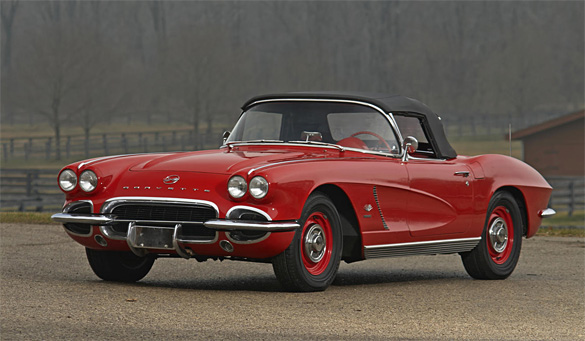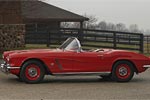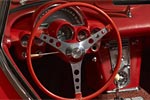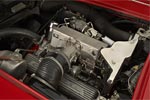The other day I was researching an article about the upcoming Scottsdale auctions when I happened across a consignment at Bonhams® for a 1962 Corvette, an unadorned little picture that most collectors, even Corvette collectors, might pass right on by without giving it another thought.
I mean, even if you were looking for a first generation Corvette (there are over sixty other C1’s from which to choose during auction week in Scottsdale) you probably wouldn’t have paused on this one. And a good automotive journalist would never look here for a story. A good automotive journalist would spend their time writing about more flashy and exciting big block L88’s or the gorgeous Regal Turquoise 1958 C1 belonging to GM CEO Dan Akerson. And why not, they are great cars and sure to draw the attention of any “Corvetter”.
So what caught my eye about the plain little picture of the red Corvette listed in the London company’s catalog? I’m not sure what it was that prompted me to give it more than a cursory look, call it “providence” if you believe in that sort of thing. First, I am not in the market for a first generation Corvette and second, it certainly did not appear to be a car that would lead to an interesting story.
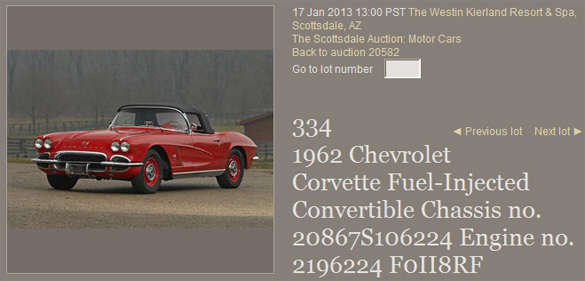
Written beside it in print so small that I could barely make out:
Lot #334
1962 Chevrolet Corvette Fuel-Injected Convertible
Chassis no.20867S106224 Engine no. 2196224 F0118RF
Estimate:
$ 80,000 – 100,000
£ 49,000 – 62,000
€ 61,000 – 76,000
The “marketing” of the car certainly was a testament to legendary British understatement. At first one might think it was unremarkable, especially by Bonhams® standards, where some of the finest and most expensive automobiles, art and antiques in the world cross the block. The presale estimate did not seem out of line especially for a car in a Bonhams® catalog. But Bonham’s is known for selling some of the finest art, antiques and autos in the world. So there had to be more than the unadorned picture would indicate. Whatever my motivation I clicked on the lot number.
Lot #334 was one of 1,918 ordered with the 327 cubic inch, 360 HP, Rochester fuel-injected V8, the most potent available engine in 1962, known as a “fuelie”. In addition the Roman Red roadster had a 4-speed transmission and Positraction.
Interesting, but nothing to get too excited about, as C1 Corvettes go. I mean there were 1,918 “fuelies”, not like it is one of five. There had to be more. And then I saw it, why the exclusive auction company had consigned this car. Sure the car is a collectible Corvette but being “collectible” is not always enough to make it into a Bonhams® auction. What made this car stand out and set it apart from other 1962 Corvettes was the provenance. This particular “fuelie” had been owned by David E. Davis. And the irony of the situation is that the simple, plain little picture of the car is the antithesis of the man who owned it. If you are under fifty you may ask, just who was David E. Davis and why should I care?
To cut to the chase: if you are a car enthusiast then you have in some way been touched by Davis, you have been affected in some manner by the effect he had on automobiles, their evolution and the entire US auto industry. The impact he had on the industry and the automobile simply cannot be overstated. David E. Davis was the father of automotive journalism as we know it today. He was an editor, a publisher, an advertising executive, briefly a race car driver, and always the consummate automobile enthusiast. He had perfected the art of Southern storytelling, raising automobile journalism from a trade to an art. He once said of automotive journalists, “We are enthusiasts in enthusiast heaven. Our automobiles are our politics and people who like automobiles are our constituency!”
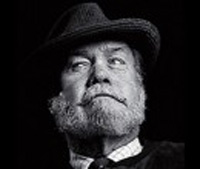
David E. Davis, Jr. used by permission of Automobile Magazine®
Perhaps the most significant impact he had on the automotive journalism and subsequently the automobile came when he became a contributing journalist to Car & Driver magazine in 1962, rising quickly to editor, and later at Automobile, the magazine he founded in 1986, as he continually goaded the automobile manufacturers to build better cars, improve quality, mileage, and performance and goaded other journalists to “tell a better story”. He changed the way automotive journalists wrote about cars and was responsible more than anyone else for breaking down the traditional European sports car enthusiast’s disdain of American cars, especially the Corvette and muscle cars. Shortly after becoming the Editor-In-Chief of Car & Driver, he began to transform it to a publication that printed honest evaluations of tested cars regardless of what the manufacturers thought and was continually under the threat of cancelled advertising contracts. Under his tutelage Car & Driver broadened its appeal to all types of enthusiasts, not only European sports car aficionados, and evaluated all types of cars, not limiting tests to European sports and luxury cars to whom other publications pandered.
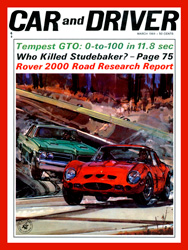 Because of David E. Davis, Car & Driver single-handedly validated the United States “muscle car” when he shocked most automobile readers by publishing the road test of a new American high performance car, the Pontiac GTO. And if that wasn’t sufficient heresy, he added insult to injury infuriating the “old guard” even more when he wrote in the article that Ferrari had never earned the name GTO so “Pontiac built a faster one!” In the comparison test, the Pontiac, tweaked by Royal Pontiac® in Detroit before the test, clearly outperformed the Ferrari and in so doing went on to iconic status. The “muscle car” era had been born but perhaps more importantly had survived by the validation bestowed on it with Davis’s powerful pen.
Because of David E. Davis, Car & Driver single-handedly validated the United States “muscle car” when he shocked most automobile readers by publishing the road test of a new American high performance car, the Pontiac GTO. And if that wasn’t sufficient heresy, he added insult to injury infuriating the “old guard” even more when he wrote in the article that Ferrari had never earned the name GTO so “Pontiac built a faster one!” In the comparison test, the Pontiac, tweaked by Royal Pontiac® in Detroit before the test, clearly outperformed the Ferrari and in so doing went on to iconic status. The “muscle car” era had been born but perhaps more importantly had survived by the validation bestowed on it with Davis’s powerful pen.
* Car & Driver March 1964 Issue GTO vs GTO Used by permission of Car&Driver®
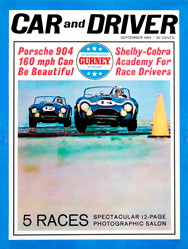 Throughout his tenure at Car & Driver, Davis continually strived to raise the bar on editorial content and often said that he didn’t just want Car & Driver to be a great “automobile” magazine, he wanted Car & Driver to be a “great magazine”, period. Usually controversial, sometimes confrontational, he managed to turn the struggling magazine into one of the most popular automobile magazines in the world through his refreshingly honest and interesting reviews. He often admonished auto manufacturers and their products in his scathing, sometimes sarcastic but always eloquent literary style. Long before it became the popular practice, he chastised the domestic auto manufacturers for their “myopic” vision of their products and the future, warning of the consequences of ignoring “quality issues”.
Throughout his tenure at Car & Driver, Davis continually strived to raise the bar on editorial content and often said that he didn’t just want Car & Driver to be a great “automobile” magazine, he wanted Car & Driver to be a “great magazine”, period. Usually controversial, sometimes confrontational, he managed to turn the struggling magazine into one of the most popular automobile magazines in the world through his refreshingly honest and interesting reviews. He often admonished auto manufacturers and their products in his scathing, sometimes sarcastic but always eloquent literary style. Long before it became the popular practice, he chastised the domestic auto manufacturers for their “myopic” vision of their products and the future, warning of the consequences of ignoring “quality issues”.
* C&D Takes on the Cobra used by permission of Car&Driver®
On one occasion he parked a Ford® Pinto in front of a junkyard for the picture to support his review of the car. Ford® withdrew their advertising from the magazine and shortly after it was discovered that the Pinto gas tanks frequently blew up. On another occasion he wrote that the radio in a BMW, the then “darling” of most of the automotive magazines, couldn’t pick up a New York radio station if it was on the other side of the George Washington bridge. Though pressured to retract the comment, Davis stood his ground. The controversy escalated and still Davis would not submit to the pressure being applied by the managing editor. He left Car & Driver in 1967, over the dispute with Leon Mandel who, as stubborn as Davis, insisted Davis apologize to BMW® or leave. Mandel, an automotive legend in his own right, was saddled thr with the dubious distinction of having fired the iconic Davis. Dutch Mandel, Leon’s son and Autoweek’s associate publisher and editorial director, later said that David E. Davis, Jr. “taught multiple generations what great automotive journalism looked like.”
David E., as he was known to his friends, went to work for Campbell-Ewald®, at that time GM®’s advertising agency, where he worked on the Corvette and other Chevrolet marketing programs. He was instrumental in developing the ad campaign, “Baseball, Hot Dogs, Apple Pie, and Chevrolet”. The campaign has been heralded in the industry as the greatest automobile campaign ever. Though highly successful as an adman, Davis, the consummate writer and storyteller, returned to Car & Driver in 1976 to continue what he had started, building the automotive magazine into what would eventually become the world’s largest.
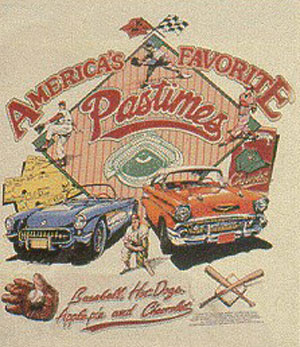
Davis created Baseball, Hot Dogs, Apple Pie and Chevrolet Ad Campaign
In 1986, with some other Car & Driver employees, Davis left Car & Driver to found his own creation, Automobile magazine, with the financial backing of Rupert Murdoch. The new magazine touted the motto “No boring cars,” an appropriate mantra for the world’s consummate auto enthusiast. Automobile was more of a “life style” magazine than strictly a “nuts and bolts” automobile periodical. Davis called on some well known writers, such as P.J. O’Rourke and David Halberstam to contribute their literary talents to his new magazine. In addition he hired Robert Cumberford, a former GM designer, to be a regular contributor offering his opinions and analyzing the most current automobile styling attempts from the manufacturers. Davis mentored several of today’s most successful and knowledgeable automobile journalists and was one of the first editors to recognize and promote women into the editorial ranks. Jean Jennings, the current editor-in-chief of Automobile, attributes much of her success to Davis’s tutelage.
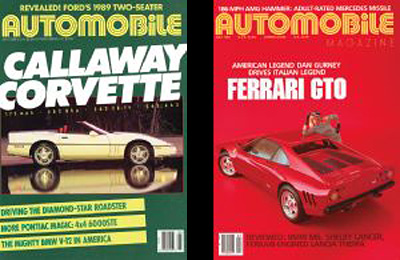
David E. Davis founded Automobile® backed by Rupert Murdoch used by permission of Automobile® Magazine
Sometimes accused of being haughty and aloof, always caustic, with a “penchant for the unpredictable charge” according to Brock Yates, life-long friend and sometimes target of Davis’s charges, it was all an elaborate concoction that influenced his “colorful” literary style and set him apart. It was those same characteristics which, irritated, aggravated and, at the same time, influenced and impacted the industry. Once during a speech in Washington, at a time when GM was struggling financially because of slow sales, due in part because much of the management was not comprised of “car enthusiasts” and as a result were not building the type of cars the public wanted, he compared the managers at GM to piano players in a whore house, “aware of what was going on upstairs but unable to do much about it even if they were so inclined.” Rather than take the comment in the critically constructive manner Davis intended, it so incensed GM they pulled their ads from his magazine. The magazine survived, many of those managers did not.
David E. occupies a special spot in my life. He was one of the literary influences that prompted and inspired me to write. Each month I waited with anticipation for my subscription to Car & Driver to arrive and read what Davis and the other editors at Car & Driver had to say. Davis had managed to assemble some of the greatest automotive journalists in the world at the magazine: Brock Yates, Warren Weith, and Patrick Bedard just to name a few. They told their stories not in the drab, dreary and usually boring style that populated the pages of other publications, but in a more compelling and colorful style more akin to novelists. He challenged established journalistic practices and styles in favor of a flowery more literary way of conveying his point, similar to other great Southern storytellers. He never asked, “How are you doing?” but rather, “Is your life a rich tapestry?” And “walking the talk” he wrote, like he advised his protégés, like he spoke and in the process he elevated automotive journalism to an art.
Arguably David E. Davis has impacted the automobile industry as much as any single individual. Automobile styling, quality and performance have all profited from his constructive criticisms and the cars today are better because of him. Journalism is better. There is no greater example of “the pen being mightier than the sword”, especially when that pen was in the hands of David E. Davis.
Rick Tavel writes about automobiles with an emphasis on Corvettes and the hobby in general. You can email him at [email protected]
Sources:
Bonhams
All Car & Driver and Automobile images and magazine covers used with permission
Related:
Corvette Ad Watch: The Genius of David E. Davis Jr
[VIDEO] GM CEO Akerson’s 1958 Corvette to be Sold at Barrett-Jackson
-

